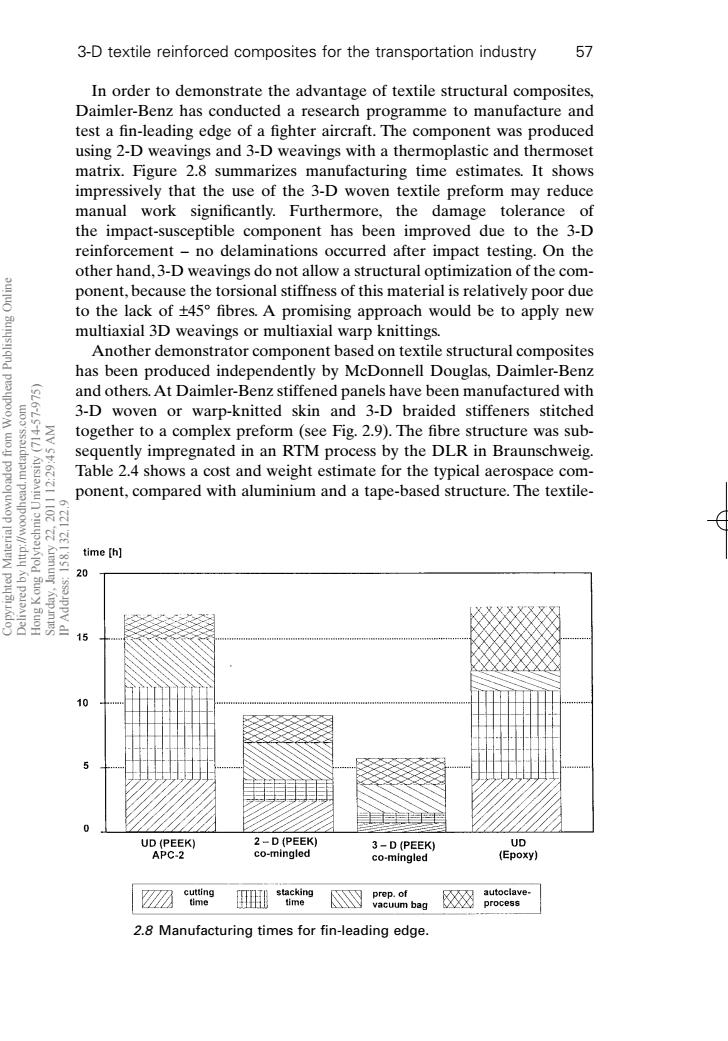正在加载图片...

3-D textile reinforced composites for the transportation industry 57 In order to demonstrate the advantage of textile structural composites, Daimler-Benz has conducted a research programme to manufacture and test a fin-leading edge of a fighter aircraft.The component was produced using 2-D weavings and 3-D weavings with a thermoplastic and thermoset matrix.Figure 2.8 summarizes manufacturing time estimates.It shows impressively that the use of the 3-D woven textile preform may reduce manual work significantly.Furthermore,the damage tolerance of the impact-susceptible component has been improved due to the 3-D reinforcement -no delaminations occurred after impact testing.On the other hand,3-D weavings do not allow a structural optimization of the com- ponent,because the torsional stiffness of this material is relatively poor due to the lack of +45 fibres.A promising approach would be to apply new multiaxial 3D weavings or multiaxial warp knittings. Another demonstrator component based on textile structural composites has been produced independently by McDonnell Douglas,Daimler-Benz and others.At Daimler-Benz stiffened panels have been manufactured with 3-D woven or warp-knitted skin and 3-D braided stiffeners stitched together to a complex preform (see Fig.2.9).The fibre structure was sub- S:6C sequently impregnated in an RTM process by the DLR in Braunschweig. Table 2.4 shows a cost and weight estimate for the typical aerospace com- 2-10 ponent,compared with aluminium and a tape-based structure.The textile- time [h] 0 :ssappv dl 15 UD (PEEK) 2-D(PEEK) 3-D (PEEK) UD APC-2 co-mingled co-mingled (Epoxy) ☑ cutting stacking prep.of time vacuum bag 级 autoclave Drocess 2.8 Manufacturing times for fin-leading edge.In order to demonstrate the advantage of textile structural composites, Daimler-Benz has conducted a research programme to manufacture and test a fin-leading edge of a fighter aircraft. The component was produced using 2-D weavings and 3-D weavings with a thermoplastic and thermoset matrix. Figure 2.8 summarizes manufacturing time estimates. It shows impressively that the use of the 3-D woven textile preform may reduce manual work significantly. Furthermore, the damage tolerance of the impact-susceptible component has been improved due to the 3-D reinforcement – no delaminations occurred after impact testing. On the other hand, 3-D weavings do not allow a structural optimization of the component, because the torsional stiffness of this material is relatively poor due to the lack of ±45° fibres. A promising approach would be to apply new multiaxial 3D weavings or multiaxial warp knittings. Another demonstrator component based on textile structural composites has been produced independently by McDonnell Douglas, Daimler-Benz and others.At Daimler-Benz stiffened panels have been manufactured with 3-D woven or warp-knitted skin and 3-D braided stiffeners stitched together to a complex preform (see Fig. 2.9). The fibre structure was subsequently impregnated in an RTM process by the DLR in Braunschweig. Table 2.4 shows a cost and weight estimate for the typical aerospace component, compared with aluminium and a tape-based structure. The textile- 3-D textile reinforced composites for the transportation industry 57 2.8 Manufacturing times for fin-leading edge. RIC2 7/10/99 7:25 PM Page 57 Copyrighted Material downloaded from Woodhead Publishing Online Delivered by http://woodhead.metapress.com Hong Kong Polytechnic University (714-57-975) Saturday, January 22, 2011 12:29:45 AM IP Address: 158.132.122.9